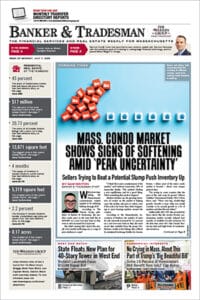
Kevin Kiley – Helps small banks
Expanding the reach of local banks across the commonwealth is at the core of the latest tri-association project to come to fruition.
The NYCE Shared Deposit Program is the culmination of a year’s work by a deposit-taking task force, which was established locally by the banking industry in response to institution requests to create some type of program similar to the defunct X-Press 24.
“The goal of the program is to increase access for consumers and business where they can take advantage of deposit-taking in locations above and beyond those of their own individual institutions,” said Kevin F. Kiley, executive vice president and chief operating officer of the Massachusetts Bankers Association.
According to MBA President Daniel J. Forte, the program is a “win-win” for consumers and bankers. “It provides consumers options. Consumers will now have the convenience of being able to deposit funds at a participating NYCE ATM that is not their home bank’s and have those funds credited to their own bank account. Separately, community bank customers will have the added convenience of making deposits at participating NYCE ATMs throughout the commonwealth without giving up that personal touch,” said Forte.
BayBank started the X-Press 24 deposit-taking network, and BankBoston continued the program after the merger of BayBank and Bank of Boston. When Fleet and BankBoston merged last year, Fleet began selling off units that were not part of the company’s core operations or did not have the critical mass to generate returns, said spokesman Bruce Spitzer at the time. Fleet found a buyer for X-Press 24 in NYCE, the electronic funds network that administers the SUM surcharge-free ATM program. NYCE acquired the network in April for an undisclosed price, and will administer the X-Press 24 network until member contracts expire.
At the time of the sale, X-Press 24 served 53 financial institutions with 116 ATMs.
‘Risk-Based System’
Customers of the NYCE shared-deposit ATM program will be able to make deposits at some 200 ATMs representing more than 40 institutions. That number is expected to grow, said Kiley. While that pales in comparison to the 1,700 machines in the SUM network, Kiley, said the two are very different services. “So, consequently, the interest on the deposit-taking side may not be as great as it was on the access side. That being said, I think over the next three to six months we’ll see what the overall industry reaction and interest is,” he said.
The program is easy to explain for consumers: a cardholder from one bank would make a deposit at another financial institution’s ATM. Then the deposit would be transferred to the member bank with a nominal fee charged for labor, said Kiley.
While it sounds simple enough, there are more complex issues at stake. “That’s why I’m saying it’s a little more complex than just providing access to cash. You’ve got to balance the machines, you’ve got to do the reconciliation and so it’s a much more labor-intensive and risk-based system,” he said.
“Each bank is going to make a judgment as to their interest in participating. Some of the key issues are liability, how you moderate any potential risk; all of those are factors I think they weigh in determining whether it is right for [the] institution,” he said.
The program will be marketed on three levels, said Kiley. NYCE will post on its Web site a way for people to find where the ATMs are located by city. Secondly, NYCE has developed a brand decal which will be affixed to all participating ATMs. On an association level, the task force is looking into possibly producing brochures and other marketing materials such as statement stuffers. Lastly, individual banks may choose to do additional marketing, said Kiley.
“We believe it’s helpful to small and medium-sized community banks and credit unions to be able to expand their footprint by having access to deposit taking,” said Kiley. Additionally, some financial institutions want to give their commercial customers the ability to make night deposits through ATMs, he said.
According to Massachusetts Credit Union League Senior Vice President for Public Relations and Marketing Robert B. Kimmett, about one-third of the institutions participating in the new program are credit unions.
“Basically, it’s just a question of identifying resources that some credit unions may find beneficial,” he said. This provides another tool for credit unions to use to reach out to customers.
“There’s a great deal of difference in the way institutions might use it,” he said, listing the night depository as one potential use for commercial banks. “The credit union typically has a member who might use the credit union for a lot of services but not be physically near a branch and occasionally find themselves with a handful of small checks looking for a place to deposit,” he said.
“It’s not a product that necessarily every institution has an interest in. There were some that have members, though, that like this convenience,” said Kimmett.
The Community Bank League of New England also supports the program, saying it will “complement the already-successfully SUM program.”
The trade groups launched SUM in September 1998, after two years of contentious debate in the State House about an ATM surcharge ban. In SUM, member banks and credit unions can provide free ATM access to their customers, but can still charge access fees to customers from outside of the network.






